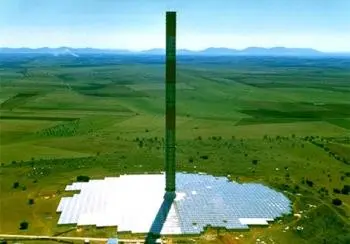
In the search for cleaner and more sustainable energy sources, air convection solar towers, also known as solar chimneys, have emerged as a promising solution. These ingenious structures use the principles of air convection to generate electricity efficiently and environmentally friendly. In this article, we will explain what an air convection solar tower is, how it works, and the potential benefits and challenges associated with this technology.
What is a solar air convection tower?
An air convection solar tower is a unique power generation installation that harnesses the natural convection of air to produce electricity.
The basic structure consists of three main components: a large transparent collector roof, a tall central tower and a series of wind turbines. The operation of an air convection solar tower is based on the principle of taking advantage of temperature differences between the ground and the atmosphere to create an air flow that drives turbines, generating electricity.
Operation of a solar air convection tower

- Collector roof : The first critical component is a large, transparent collector roof made of glass or plastic that is placed close to the ground. The collector roof serves as a solar heat trap, allowing sunlight to penetrate and warm the air beneath it.
- Greenhouse effect : Sunlight passes through the collector roof and heats the air in the area below. The ground absorbs solar radiation and heats up, creating a significant temperature difference between the ground and the colder air in the atmosphere.
- Natural convection : As the air under the collector roof heats up, it rises due to the principles of convection. This upward movement creates an area of low pressure at the base of the central tower.
- Central tower : Warm rising air is directed toward a tall central tower, which acts as a chimney. The tower is located in the center of the collector roof and has a considerable height, typically hundreds of meters. The temperature difference between the hot air and the outside air outside the tower creates an updraft.
- Airflow : As air rises inside the tower, it accelerates, generating a strong and constant airflow. This upward moving air passes through a series of wind turbines located at the base of the tower.
- Electricity generation : High-speed airflow spins the blades of wind turbines, which are connected to generators. This rotation generates electricity that can be distributed to homes, industries or the electrical grid.
- Air recirculation : After passing through the wind turbines, the air continues to rise, creating a closed cycle as it returns to the ground, where it is reheated under the collector roof. This continuous convection cycle ensures a constant source of energy.
Advantages of air convection system
Air convection solar towers offer numerous advantages that contribute to their appeal as a sustainable energy source:
- Clean energy: These towers generate clean, renewable energy, without emitting greenhouse gases or harmful pollutants, making them environmentally friendly.
- Continuous Power Generation: Air convection solar towers can continuously produce electricity during daylight hours, and their heat storage capacity allows for some power generation after sunset, improving reliability.
- Low operating costs: Once built, operating costs are relatively low, reducing the long-term cost of energy production.
- Small environmental footprint: These towers require less space compared to other renewable energy technologies, such as solar farms, and have minimal impact on local ecosystems.
Disadvantages and limitations
Despite their potential benefits, air convection solar towers also face drawbacks and limitations:
- High initial costs: Building an air convection solar tower can be expensive, requiring substantial investments in materials and infrastructure.
- Limited efficiency: The efficiency of the technology may be lower compared to other renewable energy sources, such as solar photovoltaics and wind turbines.
- Space Requirements: These towers require a large footprint, which can be a challenge in densely populated areas or where land is expensive.
- Location dependent: Air convection solar towers are most effective in regions with high and constant solar exposure, which limits their geographical suitability.
- Environmental impact: Depending on the location, the towers may have a potential impact on local bird populations as they may be attracted by the upward flow.